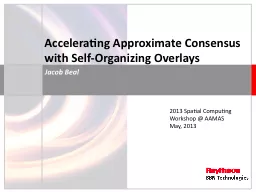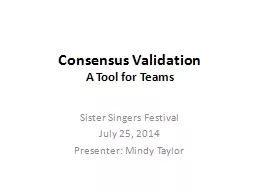PPT-Consensus V. Arun Computer Science
Author : joyousbudweiser | Published Date : 2020-11-06
University of Massachusetts Amherst 1 Problem statement Highlevel goal To allow a set of distributed processes to choose a decision value from a set of values
Presentation Embed Code
Download Presentation
Download Presentation The PPT/PDF document "Consensus V. Arun Computer Science" is the property of its rightful owner. Permission is granted to download and print the materials on this website for personal, non-commercial use only, and to display it on your personal computer provided you do not modify the materials and that you retain all copyright notices contained in the materials. By downloading content from our website, you accept the terms of this agreement.
Consensus V. Arun Computer Science: Transcript
Download Rules Of Document
"Consensus V. Arun Computer Science"The content belongs to its owner. You may download and print it for personal use, without modification, and keep all copyright notices. By downloading, you agree to these terms.
Related Documents














